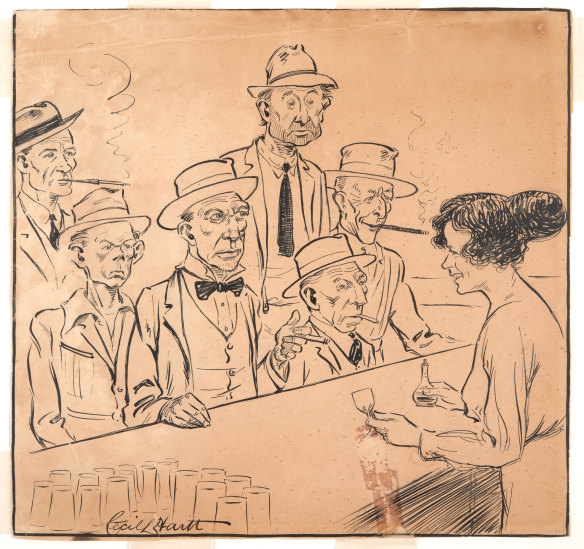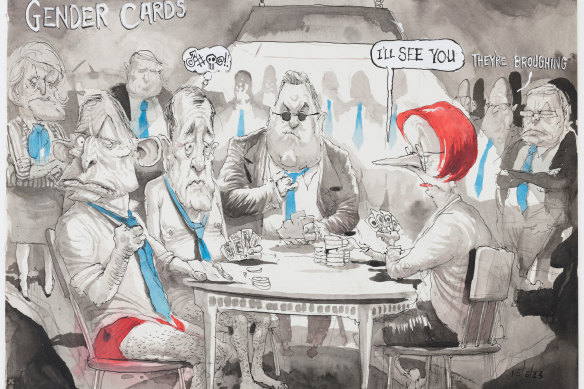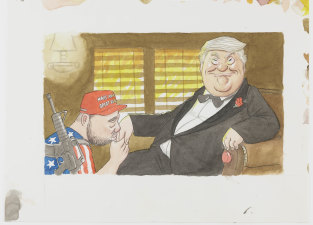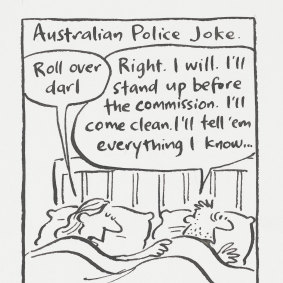These are the cartoons that kept Australians laughing for a century
By Helen Pitt
What happens when 24 cartoonists and a poet walk into a Sydney artist’s studio together and drink lots of beer?
It sounds like the start of a bad joke. But it was the beginning of the first association of newspaper artists in the world: the Society of Australian Black and White Artists Club, which formed exactly a century ago, on July 17, 1924.

This group portrait of members of the Australian Society of Black and White Artists in 1924 by founding president Cecil Hartt, featuring then PM Billy Hughes, is in the new State Library display.Credit: Cecil Hartt
At that first gathering they elected Cecil Hartt, the first staff artist at Smith’s Weekly, as founding president. Hartt, like his cartooning contemporaries, was considered to be as handy with a glass as he was with a pencil, which may be why The Bulletin writer Henry Lawson called the collective “Beerhemians”.
On Wednesday, the Australian Cartoonists Association, as it is now known, will celebrate a century to the day since its formation in a display of more than 70 works at the State Library of NSW.
A Century of Satire includes work by May Gibbs, Mr Squiggle creator Norman Hetherington, Sydney Morning Herald cartoonists John Shakespeare, Alan Moir and George Molnar, the Financial Review’s David Rowe and The Age’s Bruce Petty.
NSW Minister for the Arts John Graham will open the show, which pays tribute to the association whose members’ behaviour was so outrageous at their 1924 Black and White Artists Ball that further artists’ balls were banned from the Sydney Town Hall.

Gender cards by David Rowe, which featured in The Australian Financial Review in 2013.Credit: David Rowe
It was a particularly blokey profession until World War II, when female cartoonists Mollie Horseman and Joan Morrison, known as the “Smith sisters,” began drawing. Since then, the likes of Jenny Coopes, Fiona Katauskas and current ACA president, The Sydney Morning Herald editorial cartoonist Cathy Wilcox have dominated the field.
“Cartoonists of the early 20th century were often skilled and self-taught in many areas. The cartoonists of Smith’s Weekly wrote articles and poetry and were often part of a cohort of other fine artists, like Norman Lindsay,” Wilcox says.
“Cartoons still serve the purpose of pushing back against abuse of power and giving readers permission to feel they are not alone in perceiving hypocrisy and unfairness.”
The show’s curator, Elise Edmonds, says she trawled the State Library’s extensive black-and-white art collection to find cartoons from the past century that still resonate today.

Make America great again – Donald Trump the godfather, 2020 by John Shakespeare, features in the State Library of NSW’s A Century of Satire exhibition.Credit: John Shakespeare
“There’s been some common themes in Australian cartooning, from war, poverty and the cost of living, which are as relevant today as they were in the Great Depression in the 1930s,” Edmonds says.
“Petrol, mortgage and housing costs are favourite subjects, as has been fears of over-development, particularly in Sydney from the 1970s on.
“Politicians are constant fodder, from the rise of dictators from the 1930s to former PMs Bob Hawke, Paul Keating and John Howard.

Work by Australian Cartoonists Association President Cathy Wilcox features in A Century of Satire at the State Library of NSW.Credit: Cathy Wilcox
“The idea of the show is to revel in the dark humour, and show how cartoonists create comedy out of the times in which we live,” she says.
A Century of Satire runs until December 2024.
Find out the next TV, streaming series and movies to add to your must-sees. Get The Watchlist delivered every Thursday.